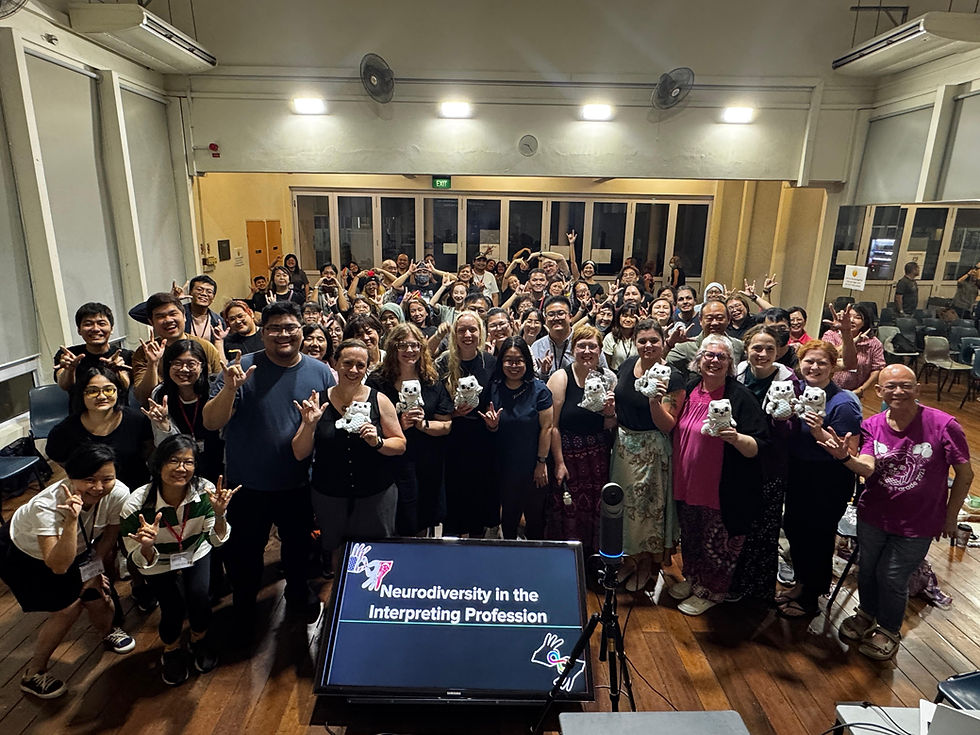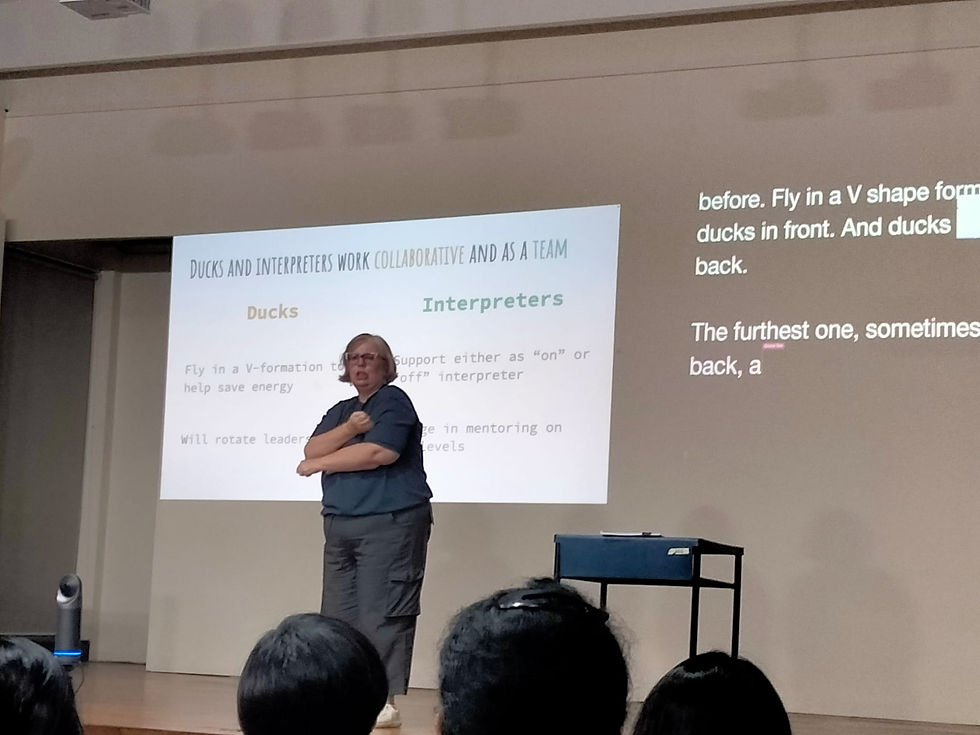The Bethel University Interpreter Training Program in Singapore
- Phoebe Tay
- Aug 3
- 5 min read
On Sunday, 13 July, the day following the conclusion of the interpreter training by the Bethel University team that took place from 7 to 12 July, I received an encouraging email from one of the participants.

Dear Phoebe,
Thank you so much for organising this. The extensive effort and hours put into this training event from last year is evident and I'm sure the participants thoroughly enjoyed this.
The Bethel University trainers were so warm and open with the sharing of their knowledge and ideas. The foundation they set gives the new interpreters a solid ground to start off from and explore further.
What I'm also grateful for is that it brought together many groups of people, interpreters and the Deaf community - young and old.
It was like a family reunion and I was happy to meet so many people whom I would not have the chance to, otherwise.
My deepest heartfelt thanks, Phoebe. ❤️
This participant has clearly articulated what I had hoped the training would achieve - bringing various groups together as there are limited opportunities for intergenerational mixing among deaf and hearing signers in Singapore. More than 160 people registered for the training - some only on certain days and others for the whole week. Therefore, the number of people attending the event fluctuated each day. About an average of 70 to 80 participants showed up each day, with some walk-ins.
I didn't know at least half of the people who signed up. So, one of the best parts of the training was getting to meet and chat with new folks every day. It helped me grow my network and made me realise there are still many people out there whom I have yet to meet.
Key Highlights of the Training

One of the most significant aspects of the training was observing the synergy among the whole team of US professional interpreters and student interpreters: Dr. Laura Polhemus, Amanda Kennon, Rebecca Buchan, Mikaela Jordan, Amber Ballard, Abigail Nava-Taylor, Melody Seager, and Shalyn Rathbun.
They did a great job showing what "Be a Duck" means, and demonstrated what effective teamwork looks like. This kind of collaboration and trust among the team was something one trainer couldn't have pulled off alone. You could see their teamwork in action during the training, especially when they took turns presenting and doing voice-over interpreting.

The trainers were very dynamic, and the large turnout brought a lot of life and energy to the venue. You could totally feel the buzz in the Singapore Association for the Deaf (SADeaf) hall. I was so hyped up and overstimulated from all the interactions during and after the training sessions that it was tough to fall asleep each night. Consequently, I had to catch up on sleep for a few days after the training week as I was completely wiped out.
We received a mix of positive feedback and helpful suggestions from several participants about what they appreciated, what they wanted more of, and what could be improved. For some of the more experienced interpreters, much of the content was familiar and served as a useful refresher, though they expressed interest in going deeper. For others, the material was completely new, and they learned a great deal. Overall, the event successfully reinforced existing knowledge for experienced interpreters, introduced new insights to others, and helped raise awareness of the role of a sign language interpreter.
Here’s a peek at what went on during the training...
Thank you to Iqah for your time and efforts in signing and filming this story so that the trainers could use it for an activity for the Thursday night session.
On Saturday 5 July, when the US team arrived in Singapore, we went to the SgSL tour at the Singapore Art Museum led by three deaf guides in the afternoon. We then attended The Saturday Service at 5 pm at Wesley Methodist Church and enjoyed dinner at YWCA after. Here are some photos capturing the fun we had outside of training during the week...
I would like to express my heartfelt appreciation to Dr Laura Polhemus for initiating the idea for the week-long training in Singapore as part of a study abroad program for her students. I never imagined that we would meet a few years later in Singapore after meeting in Washington D.C! Thank you also to the whole team of US interpreters for their dedication in making this training a reality, including their personal efforts to raise funds for their travel and accommodation.
My sincere thanks also go to the leadership of SADeaf, specifically Josh Lye and Ernest Lee, for generously providing the venue and notetaking services at no cost. Their support played a vital role in the success of this event. I also thank the U.S. team for their dedication in providing voice-over interpreting, and a few of the hearing Singapore interpreters who stepped in to assist at intervals. Thank you to the SADeaf notetakers for ensuring accessibility throughout the event. I’m also deeply grateful to Daniel Yong for his invaluable assistance with logistics, which significantly streamlined the overall coordination process.
Thank you for the continued conversations, both in WhatsApp groups and in person, that have taken place from time to time since the training ended. It was encouraging to see a participant recently reflect on what they had learned during the training in one of the WhatsApp groups I am in.
Thank you to everyone who participated in the training and to all who gave valuable feedback. Many people contributed in smaller but meaningful ways, and I deeply appreciate the behind-the-scenes help with administrative tasks during the early planning stages. I’m also especially grateful to the six local presenters (five deaf and one hearing) who each shared on at least one topic related to the Singapore deaf landscape with the U.S. team over Zoom earlier this year during their spring semester class. Your input helped introduce them to our local signs and provided useful context about SgSL ahead of their visit.
Thank you also to a few others who took the time to seriously consider the invitation to present and wanted to capitalise on the opportunity, but had to turn it down. I hope more opportunities come your way in the future! Special thanks to the SADeaf staff who helped set up the hall, as well as to the non-SADeaf individuals who proactively reached out to offer their assistance before the event on their own initiative. Although we ultimately didn’t need additional hands, your willingness to help meant a lot. I’m also grateful to those who brought food to share and helped with the cleanup afterwards.
There are simply too many of you to name, each contributing in your own way. I’ve chosen to keep this general instead of mentioning names because I'm worried about leaving someone out. Thank you all!
Lastly, a special shout out to Emma Henriksen for reaching out to me via WhatsApp to inform me of this opportunity and for asking if I was interested in taking it on last year. Although I initially declined the offer due to being in the final stages of my dissertation and feeling overwhelmed, I'm glad I changed my mind and accepted it. Thank you to Cat Fung and Yi Hin Chan for being my sounding board when I discussed this opportunity in our WhatsApp group chat. Thanks to Cat for urging me to reconsider after I initially turned it down. Despite the challenges of balancing the administrative tasks that came with coordinating this event whilst writing my dissertation, I enjoyed the experience.
We look forward to a potential onsite training in 2027, subject to available funding and resources.




































































Comments